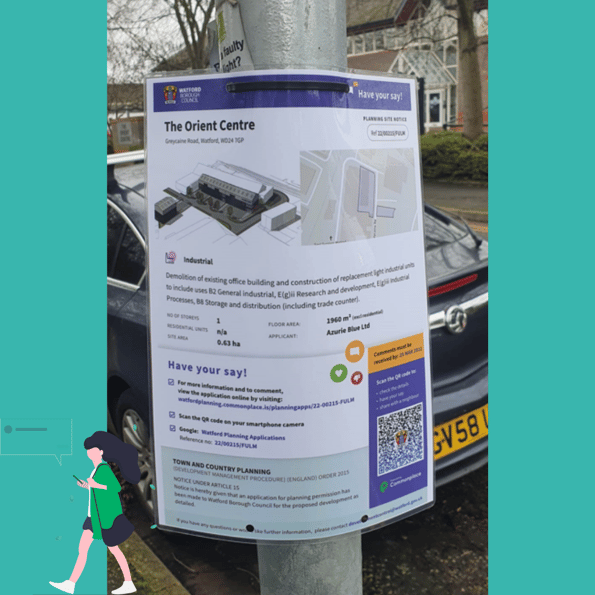Planning notices: How to view planning applications online

By Benjy Meyer | 31/03/22 15:33
4 min read
Did you know that over 400,000 planning applications are submitted in England each year? These range from small householder applications for minor property changes, to major regeneration projects delivering thousands of commercial spaces and homes.
If you're ready to digitise planning notices, our team will be more than happy to show you how. Just book a personalised consultation below and we’ll be with you ASAP.
ALL local planning authorities are required to notify the public through a site notice. You’ve probably seen your fair share taped to lamp posts and fading on notice boards. These are an extremely important (and legal) requirement for any kind of development, but ones we see these days can often find themselves lacking. Considering British weather and the attention span of the average commuter, physical site notices NEED to be, at the very least, attention-grabbing, weatherproof and have a clear call to action for those passing by. A piece of paper and sellotape simply will not do! Luckily there’s a solution. On top of making sure physical planning notices are sturdy enough to survive the wind and rain, also utilising digital planning notices can really help increase public engagement.
With this a crucial step in any planning process, we’re going to cover the best ways to create planning notices and how to get them seen by as many people as possible. After all, the goal of any engagement is getting the local community to see/comment on your proposal and the current system is a tad antiquated if we do say so ourselves.
Fighting low engagement in planning
Current engagement with planning is already low, so getting people interested in upcoming developments can feel like an uphill battle at times. Only 27% of our own survey sample had taken part in a planning decision. Not only that, but of those who had engaged, twice as many had signed a petition to oppose a development compared to those who’d actually attended any sort of planning meeting. *
An online planning notice provides a user-friendly way for people to find out about all proposals near them in an easy to understand format. Having the ability to click from a desktop or leave a comment on a proposal from their phone makes engaging that much easier.
"What are planning notices?" Helping people understand

Printed site notices are great for catching the public’s eye as they walk past, but often don’t have the space for every single detail. Text heavy documents can turn off readers and having multiple pages of explanation make it hard to stick up in a convenient way.
This doesn’t help when many people don’t know what it means to actually ‘get involved’ in planning. Does it mean taking part in and organising meetings? Contacting planners directly? Leading public opinion? In our research, many people were scared to participate as they thought they’d have to take charge and they didn't want to risk appearing 'ill-informed'.
Our research, in partnership with Innovate UK & DLUHC confirmed that most residents often ask “what are planning notices?”
- They don’t understand why they appear and disappear
- They don’t understand the words or the pictures or there’s too much jargon
- They feel self-conscious stopping in the street to read it
- They think contributing is only for people who oppose the project
- They don’t believe their opinion would actually change anything
To tackle this, people not only have to have access to information, but they need to properly understand it as well. This is where the ‘digital first’ approach comes back into play for planning notices. Having a platform where all information, as well as what’s required of the public, is clearly presented is key. This doesn’t just mean having a website, as a digital strategy should also include following up with emails, sending out regular social media posts and finding out exactly where the community usually turns for local news and updates. Your physical planning notices could have a handy QR code printed on so people can scan with their phone and be directed to all the information they need without it taking up too much page space.
Creating relevant planning notices
Planning notices receive more engagement when they’re targeted to those they are most relevant to. A sign on a public noticeboard might be passed by hundreds of people each day, but how many of them will actually be affected by this project?
With Commonplace, the local community can comment on planning applications as well as sign up for alerts about other projects in their area or that they feel are relevant to them. These are sent directly to their email so they can easily view planning applications online and help encourage a longer lasting relationship between citizen and planner- giving them the power to make a difference to projects and developments that directly interest them.
How to view planning applications online? Watford Borough Council's engagement
One of just 13 local authorities to win up to £100,000 from the Department of Levelling Up, Housing and Communities’ (DLUHC) PropTech Engagement Fund, Watford has focused its grant on vastly improving the way they use digital tools to consult the public on planning applications and planning notices.
With this new website, Watford residents can easily see and comment on the purpose and design of major planning applications that have been submitted to Watford Borough Council. Their interactive map highlights each area with a proposed development which residents can click on and then see a full summary. It’s then easy to leave a comment or subscribe for updates on that particular planning application as it develops. Each proposal also has a clear timeline showing each phase of the consultation and development so the community can stay up to date with each. Key data for each proposal is also succinct and easily digestible making it easy to understand for all their citizens.
This project also utilises 3D mockups and images so viewers can better understand the area and easily visualise the completed projects.
One of the main goals of this website was to help build trust between planners and the local community. This is why all details about each development is clearly laid out and every comment left is visible to the public. This helps dispel the notion that planning decisions happen behind closed doors or that their own friends and neighbours aren’t getting involved.
Find out more about it with our press release.
To find out more about digitising your planning notices, our team will be more than happy to show you how. Just book a personalised consultation below and we’ll be with you ASAP.
.png)

